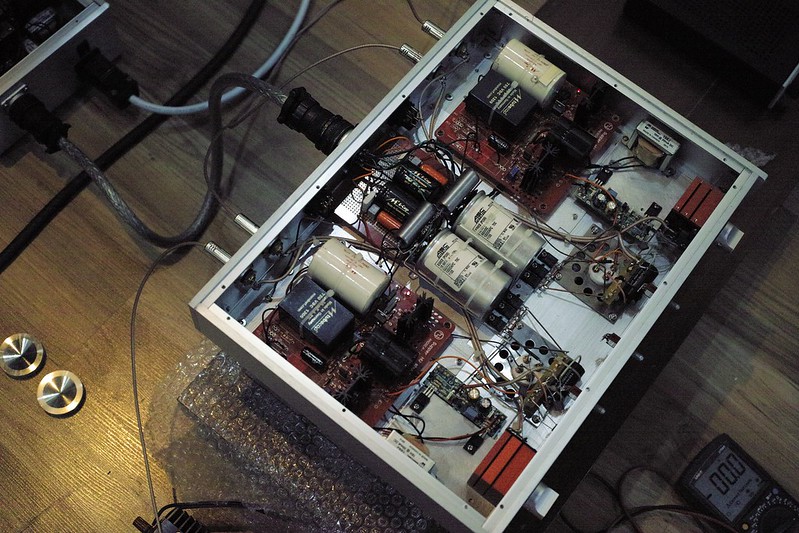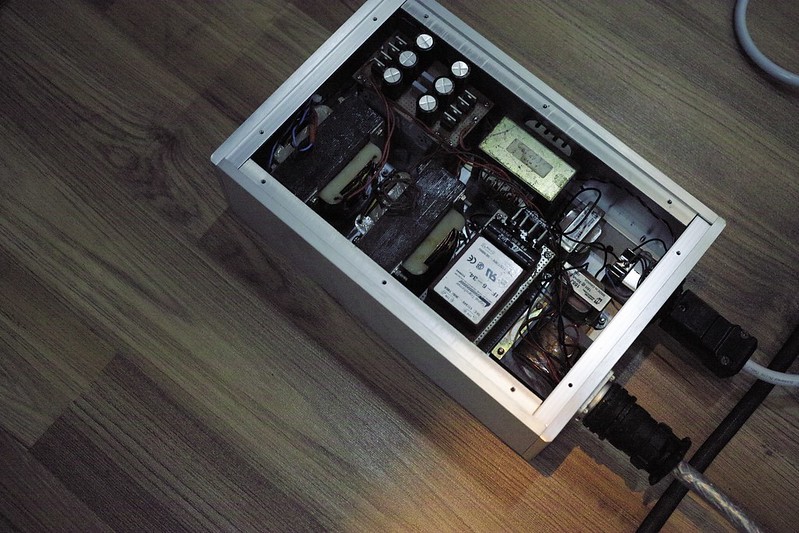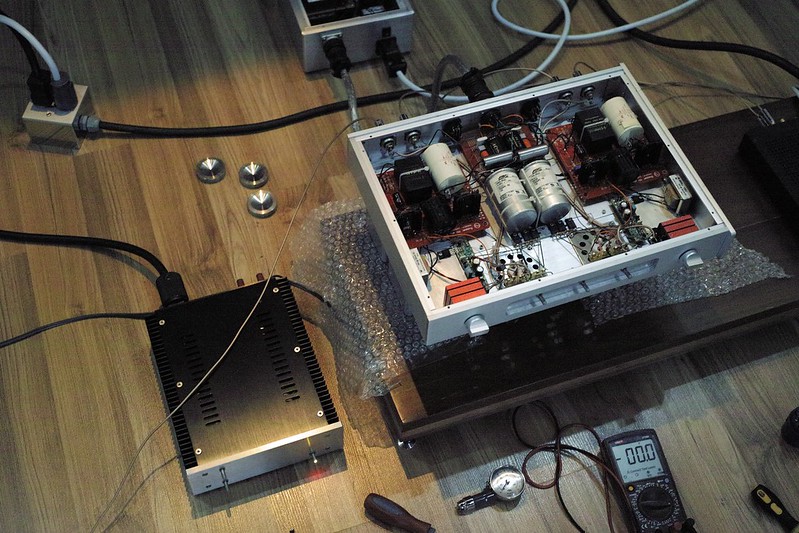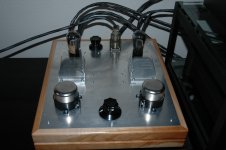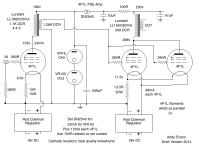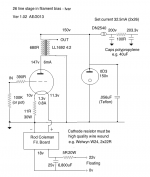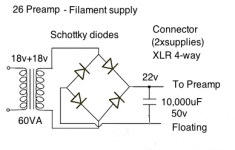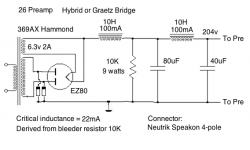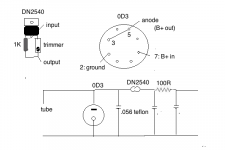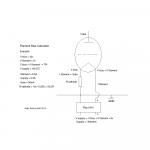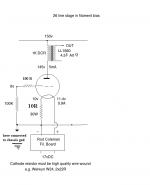Simple and quick question:
On the 255V rail for the 10Y circuit posted above, does each channel get its own ccs and VR tubes or do they both share?
Thanks!
On the 255V rail for the 10Y circuit posted above, does each channel get its own ccs and VR tubes or do they both share?
Thanks!
Hi 26 lovers!
You might enjoy my little essay about the 26 triode:
VinylSavor: Tube of the Month : The 26
Best regards
Thomas
You might enjoy my little essay about the 26 triode:
VinylSavor: Tube of the Month : The 26
Best regards
Thomas
Nice overview, Thomas!
My own personal favorite is the Sparton balloon 26. Clean and clear but with a touch of warmth. Sparton made their own tubes for a while and then outsourced to RCA; not sure who made my pair, but the plate structure is a bit different from the RCAs I have.
My own personal favorite is the Sparton balloon 26. Clean and clear but with a touch of warmth. Sparton made their own tubes for a while and then outsourced to RCA; not sure who made my pair, but the plate structure is a bit different from the RCAs I have.
Dear Sir,
Hi I'm in the process in asking a builder to build a good pre-amp for me as I'm not technically inclined. Initially I was determined to select an Aikido but after looking at this page, my mind changes a little.
Some questions
1) How does this compare to Aikido, sound quality wise?
2) I'm not an experienced builder but I'd be providing a schematic for a friend ( an experienced one ) to build. Hence, I would want a schematic that is as direct as possible so that to make it as hassle as possible. Which one should I choose?
3) Which are the more expensive parts that I have to take into account for this project as sky is not unlimited but I have a budget of say $1500. Would this be enough?
4) Is there any "problem" that would be difficult to solve ( i.e humming etc ? ) should I encounter it?
5) Any maintenance/biasing required as an when?
Sorry for so many questions. Thanks in advance.
Hi I'm in the process in asking a builder to build a good pre-amp for me as I'm not technically inclined. Initially I was determined to select an Aikido but after looking at this page, my mind changes a little.
Some questions
1) How does this compare to Aikido, sound quality wise?
2) I'm not an experienced builder but I'd be providing a schematic for a friend ( an experienced one ) to build. Hence, I would want a schematic that is as direct as possible so that to make it as hassle as possible. Which one should I choose?
3) Which are the more expensive parts that I have to take into account for this project as sky is not unlimited but I have a budget of say $1500. Would this be enough?
4) Is there any "problem" that would be difficult to solve ( i.e humming etc ? ) should I encounter it?
5) Any maintenance/biasing required as an when?
Sorry for so many questions. Thanks in advance.
My #26 tube preamp is -almost- cost no object (TVC, Elma swithes, V-Cap capacitor, Shinkoh and Riken resistors etc.) project, but the total cost is below 1500 USD (about 1000-1100).
Most effective parts:
- TX-102 TVC (it's unnecessary if you use good -for example TKD, Noble- potentiometer, or leave it);
- Elma 24x switch (it's unnecessary if you don't use TVC);
- Elma input switch;
- 100nF V-Cap teflon capacitor (use cheaper ones -for example russian FT-3-);
- AZ1 mesh rectifier tube (use good solid plate rectifier tube);
- Power supplies -HT and LT-;
- teflon tube sockets, silver connectors;
- Good -I prefer globe tubes- #26 tubes. ST tubes are cheaper.
As you can see it's a two box design (HT and LT supply, preamp).
I use regulated HT (Salas SSHV2 regulator) and Rod Coleman's V4 heater regulator in the preamp box (medium sized heat sinks needed).
Tube is heater biased, anode load is CCS (cascode DN2540 FETs). Heater bias resistor (10R 50W DALE non inductive 10W dissipation) large heat sinks is old computer CPU passive ones.
Most effective parts:
- TX-102 TVC (it's unnecessary if you use good -for example TKD, Noble- potentiometer, or leave it);
- Elma 24x switch (it's unnecessary if you don't use TVC);
- Elma input switch;
- 100nF V-Cap teflon capacitor (use cheaper ones -for example russian FT-3-);
- AZ1 mesh rectifier tube (use good solid plate rectifier tube);
- Power supplies -HT and LT-;
- teflon tube sockets, silver connectors;
- Good -I prefer globe tubes- #26 tubes. ST tubes are cheaper.
As you can see it's a two box design (HT and LT supply, preamp).
I use regulated HT (Salas SSHV2 regulator) and Rod Coleman's V4 heater regulator in the preamp box (medium sized heat sinks needed).
Tube is heater biased, anode load is CCS (cascode DN2540 FETs). Heater bias resistor (10R 50W DALE non inductive 10W dissipation) large heat sinks is old computer CPU passive ones.
Attachments
Hi 26 lovers!
You might enjoy my little essay about the 26 triode:
VinylSavor: Tube of the Month : The 26
Best regards
Thomas
Generally which one that I aim for during purchase - SQ wise.
Any tips?
I have been using them for 16yrs now in line stages and have found it to be a fussy choice, but it definitely has excellent linearity and in a good design accounting for its quirks is about as good as anything I have heard. I also like the 112/12/12A.
BTW, how scarce is the 26 tubes? I did a quick search at epay, not much available.
What are the equivalence?
What are the equivalence?
BTW, how scarce is the 26 tubes? I did a quick search at epay, not much available.
What are the equivalence?
There are no equivalents.
But I would use the 4P1L. I built my first 26 preamp in 2008 and it lasted until about 2011 in many different versions. I then went over to the 4P1L - more dynamic, better treble. And I stopped using line stages and just used a 2-stage amp. Simple as that. The first stage can be used as a line stage, of course. But the output stage is better than any 2a3 or 300b design I built, and there were several of them. With its generous mu of 10 the 4P1L can be used in a 2-stage amp, and that solves a lot of issues.
Attachments
There are no equivalents.
But I would use the 4P1L. I built my first 26 preamp in 2008 and it lasted until about 2011 in many different versions. I then went over to the 4P1L - more dynamic, better treble. And I stopped using line stages and just used a 2-stage amp. Simple as that. The first stage can be used as a line stage, of course. But the output stage is better than any 2a3 or 300b design I built, and there were several of them. With its generous mu of 10 the 4P1L can be used in a 2-stage amp, and that solves a lot of issues.
It depends of your entire setup. I don't do the same combo if I use my 2A3 amp, Citation II or SS amp. Add speakers matching...That's another game!
I thought I'd post the circuit details of a preamp I'm finishing off. Let me know if there are any glaring oversights!
Attachments
Not really an oversight but I like even less capacitance across the 0D3. In my preamp, I use an 0A2, which is a miniature 150v glow tube. I parallel it with a 0.01uf teflon cap type K72P-6. Nice and small and it sounds great.Let me know if there are any glaring oversights!
---Gary
- Home
- Amplifiers
- Tubes / Valves
- #26 pre amp
